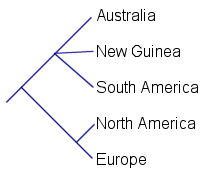BIOGEOGRAPHY, ETC.
Fall 2018
QUESTION SET 3
DUE: 15 November
1. Most higher taxa of
animals (all
major phyla, most major classes) are apparently of relatively ancient
origin, their earliest common ancestors dating to the early
Paleozoic (or even latest pre-Cambrian), not long (in the grand context) after multicellular life
first appeared.
A.
Give a hypothetical explanation (or two if you can) for why no
lineages of more recent origin have gained such status (consider what
characteristics a lineage must have to be given phylum or class
rank). Is there a parallel here with adaptive radiations 'within'
groups (like the diversification of mammalian orders in late
Mesozoic/earliest Cenozoic)?
B.
Is there a way in which you might recognize an existing organism as
the likely parent of a future adaptive radiation, or progenitor of a
future higher taxon, if you were encounter such a creature now?
2. Here are two tree
diagrams showing the relationships within a family of frogs and a
family of midges; the members of each family are identified by the
land mass on which they live; i.e.,
the frogs of Europe are most closely related to those of North
America (instead of "australia" in each graph read 'the
frog (or midge) that lives in australia'). One 'trichotomy' indicates
that the sequence of divergence can't be fully resolved. You might
find it useful to refer to the sequence of tectonic events in the
splitting up of Pangaea.
A. What's the
significance of the similarity between these two trees? What
does it suggest to you about what caused (or allowed) the lineages
that now live on these land masses to diverge (with regard to the
alternative possibilities of initial allopatry/speciation being result
of 'vicariance' or long-distance dispersal)?
B. Identify where similarity of pattern
breaks down, and offer a
hypothesis as to what that means, how it might be interpreted.
HYLID FROGS
MIDGES


3.
You now have a historical picture of the world alternating between a
condition where
most of the land is in a single large land-mass (with lower sea-levels
and, therefore,
narrower strips of shallow ocean around the continents), and a
condition where there are multiple
smaller land masses separated by ocean (with higher sea-levels, so
with wide areas of
flooded continental shelf). Combine this with what you understand about
biological
processes and patterns like evolution and species-area relationships
(review species-area relationship in textbook if called for) to offer
hypotheses addressing following questions. You can (re)view
paleo-geography of continents and oceans at http://www.scotese.com/ if
you want...
A.
How would you expect these changes to have affected diversity patterns and overall diversity
in terrestrial biota?
B.
and how might they affect diversity patterns in marine biota
(recognizing
that
much of the diversity in the oceans is in the shallow oceans – that is,
on the continental
shelves)?
4.
Historian Alfred Crosby, in his book "Ecological
Imperialism",
refers to the effects of the age of exploration and subsequent economic
globalization as 'reuniting the seams of Pangaea' -- he draws a
parallel between the effects of human activity and plate tectonic
cycles, specifically with respect to biological distributions.
What do you suppose he means by this metaphor? How
might it
inform our thinking about approaches to conserving global biodiversity?
5.
Caro-Beth Steward, as described in Dawkins and discussed in class, has used the
distribution of hominoid fossils as well as distributions of living
apes to postulate that an ape that was common ancestor of
chimps, gorillas, and humans, but a sister group to the Asian great
apes, dispersed out of Asia and into Africa (the 'out-and-in-and-out-of-Africa
hypothesis').
This theory is based primarily on a parsimony argument
regarding the number of independent movements between continents
required (see the figure in 'The
Orang Utan's Tale' -- or
the original article (with color figure) here,
if you wish).
A)
How might this hypothesis be further tested? What kinds of
evidence would be needed?
B)
How would the argument be affected if, say, a fossil apparently related
to the orangutan-Sivapithecus clade
were found in Africa?

